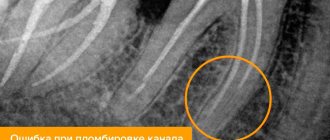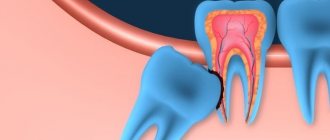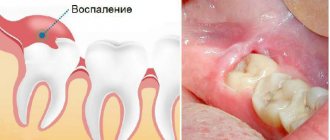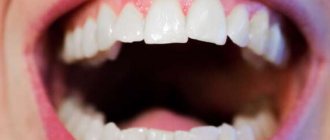Causes of pain after removal
The severity of pain depends on the complexity of the operation performed. Normally, pain may occur immediately after the anesthetic wears off, and discomfort may persist for 2-3 days. Then the symptom should subside. Sometimes dentists allow pain to persist for five days, but in the absence of other complaints.
The main cause of pain in the socket area after wisdom tooth removal is alveolitis. Inflammation of the socket develops for the following reasons:
- Highly traumatic surgical procedure.
- Incomplete sanitation of the hole, preservation of tooth fragments in it.
- Injuries to the mucous membrane during surgery, for example, with a bur when dividing roots or with forceps when applying cheeks to the walls of a tooth.
- Refusal to apply sutures if there are direct indications for the procedure.
- No course of antibiotics after complex tooth extraction.
Characteristic will be an increase in pain and the addition of other signs of inflammation. The only right decision in this situation is to visit the dentist.
What to do if the problem persists
Outside intervention in the body causes certain reactions, especially if the process was complex. Therefore, complex tooth extraction causes various side effects: swelling of the cheek, bleeding gums, fever. Patients complain of pain in the throat, ear, difficulty chewing and moving the jaws. Anomalies appear from damage to soft tissues. After all, the blood circulating there becomes free. It fills cavities, which leads to swelling. This is what prevents the patient from fully opening his mouth.
After conduction anesthesia, pathologies appear. Therefore, after wisdom tooth removal, it is painful to open your mouth and swallow. If the discomfort gradually subsides, this is normal and there is no need to worry. However, when the pain increases, becomes stronger every day, and does not go away for a long time, the patient must definitely visit a doctor. The sooner this is done, the faster and easier the therapy will be.
Re-cleaning the hole
If it hurts to open your mouth, a specialist should determine the cause of the abnormality. For this purpose, diagnosis is carried out and treatment is prescribed. Often, dentists in such situations clean the wound again. With curved roots, cysts can form and caries can develop, moving into an advanced phase. There are situations when the entire root cannot be removed at once. For the patient to recover, the surgeon must perform another cleaning. Also, this procedure is resorted to when a fragment is accidentally left behind. Pain and discomfort will go away when the wound is clean.
Physiotherapy
When the mouth is difficult to open and the jaw hurts, the following may be prescribed:
- Electrophoresis;
- Ultraviolet irradiation;
- UHF;
- Fluctuarization;
- Laser therapy;
- Magnetotherapy;
- Darsonvalization;
In addition to basic treatment, physiotherapeutic procedures accelerate healing. Complex therapy helps reduce the process of intense inflammation, eliminate discomfort, and fight pathogens.
Antibiotics
A common problem with Eights is dystopia. Since this provokes serious problems, a dystopic wisdom tooth in many cases must be removed. After all, such rudiments are located incorrectly. Their position is not vertical, but horizontal or inclined. Indications for extraction:
- Development of caries, pulpitis, periodontitis, when therapy does not bring a positive result;
- Serious damage to the unit located opposite;
- Impacted organ with inflamed mucous tissue;
- Orthodontic therapy of crowded anterior units;
Drug treatment for complications depends on the characteristics of the patient’s disease. If inflammation develops in the oral cavity, antibiotics are prescribed to eliminate the source of infection. This may be Lincomycin, Ciprolet, Dalacin, Amoxicillin or Ciprofloxacin. Antibacterial agents such as streptocide or sulfacyl can be used.
Jaw development with exercises
For patients with pain, doctors recommend rinsing with chlorhexidine, furatsilin, miramistin 24 hours after surgery. If the mouth does not open completely, the jaws should be developed. If you have difficulty moving, you need to help open the jaw with your fingers. It is important that the patient does not overdo it. Development is performed when the patient experiences mild pain. Gymnastics involves smooth opening of the mouth and soft chewing movements. The load increases gradually.
Full restoration of function will be noticeable after 15-20 days. Massage and heat therapy will help you recover faster. Moving a toothbrush with soft bristles improves blood circulation. Healing is accelerated by mud, paraffin, and ozokerite applications. In the first days, you need to exclude solid foods from your diet. It is useful to eat jelly, grated soups, and liquid porridges. On days 8-12, you can include regular dishes in the menu.
Causes of swelling after removal
Swelling of the mucous membrane in the area of removal in the gum area, as well as swelling of the cheeks, are also considered normal after wisdom tooth extraction. This is explained by tissue injury and the body’s natural reaction to the procedure. Normally, swelling increases the next day after visiting a dental surgeon, but then, if all recommendations are followed, it should subside.
If the swelling continues to increase, you should consult a doctor. The same applies to situations where, in addition to tissue swelling, there is increased pain, discharge from the socket, and increased body temperature. The listed signs indicate inflammation, which requires initiation of treatment.
The signs will be especially pronounced if there was already purulent inflammation at the time of visiting the dentist. In this case, even a correctly performed procedure, creating an outflow of inflammatory exudate, does not exclude an increase in tissue edema. When removing the upper tooth, swelling may spread to the orbital area. During surgery on the third molar of the mandible, swelling may extend to the neck and ear area. If after a day the symptom becomes less pronounced, we can assume that there are no complications.
In addition to increased swelling and pain, the following signs will be an indication for an emergency visit to the dentist:
- Discharge of pus from the socket.
- Bleeding.
- Pain when swallowing.
- Pain when trying to open your mouth.
- Swelling of the face, accompanied by redness of the skin.
It is unlikely that tissue swelling will be completely avoided, but the risk of complications can be reduced. It is enough to follow the doctor’s instructions, take prescribed medications and monitor oral hygiene.
How wisdom teeth erupt
This process occurs starting from the age of 16 or at a later age. Dentists do not consider the eruption of these teeth to be a deviation even after 40 years.
Over the years, the jaws decrease in size, and there is no room left for the “eights”. If eruption is delayed, an x-ray should be taken to see the reason.
The path of this tooth passes through fairly thick soft tissue, so the following symptoms appear:
- Pain in the problem area or radiating to the jaw;
- Redness;
- Edema;
- Difficulty eating and opening the mouth.
Other manifestations are also possible:
- Second molars suffer from root or cervical caries;
- If the swelling is extensive, the throat and gums may hurt, causing odontogenic sore throat.
How long does it take for the mucous membrane to heal after removal?
The duration of the healing process depends on a large number of factors. First of all, the difficulty of removal matters. The removal technique also has an effect, that is, extirpation of the roots in parts, cutting of the tooth. It is important to take into account the initial condition when visiting the dentist. The hole will take longer to heal if the tooth is located outside the dental arch, grew in the jaw at an angle, or was located horizontally in the dentition. The presence of an inflammatory process near the tooth, especially signs of purulent inflammation and pericoronitis, also increases the healing period.
When sutures are applied after a simple removal, within a week the patient will forget about the procedure, but it is too early to think about prosthetics or implantation. With complex removal, the healing process will take slightly longer. If complications arise after surgical treatment, wound sanitation, treatment, and suturing are required, then the time for complete healing may increase to 20 days. Complete restoration of the mucosa takes at least three weeks. Only after this can implantation and prosthetics be performed in the area of the removed wisdom tooth.
Normally, gums must go through several stages:
When going to the dentist, it is recommended to immediately plan your day. This is especially true if there are already signs of inflammation or the teeth are severely damaged, that is, a difficult extraction is expected. Recommendations after wisdom tooth removal include, first of all, complete rest on the day after surgery. You should not make sudden movements, bend over, visit baths and saunas, or take a hot bath. It is prohibited to play sports or do any work while bending over. The best option would be complete rest. There is no need to do any special procedures on the day of the operation.
Smokers are advised to abstain from cigarettes if possible for three days or more if there are signs of complications. Nicotine causes vasoconstriction and disrupts tissue nutrition, which slows down regeneration processes. In addition, the risk of wound infection increases.
After a couple of days, you should visit the dentist who performed the procedure to assess the condition of the tissue and the healing process. This must be done even if the patient is not bothered. If signs of complications appear, pain and swelling increase, and bleeding does not stop, consult a doctor without waiting for the appointed date.
If sutures were placed on the wound, they are removed after 8-10 days, or a follow-up examination is scheduled if self-absorbable material was used for the sutures.
Do not touch the wound or try to remove part of the clot or remnants of the medicine in the form of sponges. This will only worsen the situation and cause complications.
What do we have to do?
On the first day, do not rinse your mouth. From the second day, procedures can be carried out. In this case, you do not need to intensively rinse the contents of the hole; just hold the solution on the sore side for a few seconds and spit. You need to repeat the procedure several times a day, especially after meals.
Chlorhexidine, furatsilin, miramistin, and potassium permanganate can be used as a rinsing solution. It is also possible to use herbal decoctions, for example, sage, chamomile, calendula or dental collection.
Pain may occur after the anesthetic wears off. To eliminate them, the dentist must prescribe analgesics. If there is no prescription, you can take any painkiller that the patient is used to using for pain. If the pain increases and the tablets do not help, you cannot increase the dosage. An increase in symptoms indicates a complication that requires medical intervention.
If you don't want to take medication, you can use a cold compress. These can be ice cubes wrapped in a towel. They need to be applied for several minutes, avoiding hypothermia of nearby organs, in particular the ear and tonsils.
If there is a high risk of inflammation, as well as if there is purulent discharge at the time of surgery, the dentist will definitely prescribe antibiotics. The doctor calculates the name of the drug and duration of use individually.
Features of nutrition after surgery
After wisdom tooth removal, it is forbidden to eat for two hours. If after the specified time the effect of the anesthetic still persists, it is better to wait until sensitivity appears. Eating food with a numb tongue and cheeks can cause injury to the mucous membrane.
On the first day after surgery, you can only eat warm food and drinks. Products should be soft, for example, cereals, chopped soups, yoghurts. Next, you should follow simple recommendations for several days:
- Avoid hot or too cold food.
- Avoid eating hard foods such as crackers and nuts.
- Chew food only on the healthy side so as not to put stress on the wound.
- After eating, be sure to rinse your mouth.
- You can include more fruits and vegetables in your diet to boost immune strength, or supplement with complex vitamins from the pharmacy.
You cannot drink alcoholic beverages. It is also recommended to reduce sweet foods in the first days, as they create a favorable environment for the development of bacteria.
Features of oral hygiene after removal
On the first day after extirpation, you should abandon the usual brushing of your teeth, limiting yourself to a light rinse before going to bed to remove any remaining food. The next day, you are allowed to use a toothbrush and toothpaste, but the surgical site is treated with special care. When brushing your teeth, do not forget that you cannot actively rinse your mouth. After three days, the wound will have healed and you can return to your usual hygiene regimen and brush your teeth twice a day.
Features of wisdom tooth removal
The procedure depends on how the figure eight is located in the bone. If the position and growth are normal, anesthesia is first performed, then the circular ligament is detached, then the doctor applies forceps and performs gentle rocking movements.
After the tooth is unbalanced, traction is carefully performed - extraction. Final manipulations - disinfection, creating a clot for regeneration, adding medicine (if necessary). If semi-retention or retention of a tooth is observed, its removal is complicated.
Complex removal of figure eights involves cutting soft tissues, drilling out the remains of the tooth and root, and suturing the gums. After such an intervention, the recovery period takes a long period of time, and the risk of complications is high.
Why there is bad breath and what to do
The appearance of an unpleasant odor after the removal of a wisdom tooth indicates the development of an inflammatory process. In most cases, the symptom appears 3-4 days after surgery and is accompanied by tissue swelling and pain. In this case, you need to consult a doctor.
Odor may also develop due to lack of hygiene. This increases the risk of inflammatory abs, so you shouldn’t forget about brushing your teeth.
It is worth considering that some medications that doctors use to protect the socket may have a specific odor. As a rule, dentists warn the patient about this situation immediately after the procedure.
Removing a wisdom tooth is a complex procedure, but following all the dentist’s recommendations will help reduce the risk of complications to zero. Our doctors always tell patients in detail the features of the postoperative period and prescribe all prescriptions, including antibiotics and analgesics. All they have to do is follow all the instructions exactly.
Why do wisdom teeth hurt?
The appearance of a figure eight is often accompanied by fever, pain radiating to the ear, neck, enlarged submandibular lymph nodes, swelling and redness of the gums. There are many reasons why a wisdom tooth hurts; painful eruption is often associated with the following situations:
- Formation of the “hood”
- in an adult, the gum tissue is denser than in a child. Because of this, cutting through the figure eight is difficult. When only part of the tooth has erupted, and the other still remains under the gum, a section of tissue covering the erupted crown forms a specific hood. It makes further eruption of the molar difficult. The cause of pain in this situation is the inflammatory process developing under the hood (pericoronitis). - Abnormal growth
– figure eights often grow incorrectly relative to the jaw arch. Since the dentition is formed, there is not enough space for the figure eight. It begins to grow towards the neighboring unit, and the pain covers not only the area of the erupting tooth, but the entire jaw.
If a wisdom tooth that has already erupted begins to hurt, the reasons are most often the following:
- Caries
– the outer molars are located in a hard-to-reach area; it is difficult to clean them well with a brush. Bacterial plaque accumulates more in this area, causing caries. - Pulpitis -
a carious lesion extends beyond the enamel, dentin, and affects the tissue of the pulp chamber (neurovascular bundle). Pulpitis is accompanied by severe, throbbing pain. Endodontic treatment of figure eights does not differ from the techniques applied to other dental units. - Periodontitis is
inflammation of the tissue around the tooth root. It can be acute or chronic. The cause of the development of periodontitis is untreated pulpitis, trauma to the eighth molar, depressurization of a previously filled root canal and penetration of infection into it, and incorrect position of the tooth in the row.
Unpleasant sensations can intensify with the development of diseases of the oral cavity, infection of the dental canals, the formation of cysts, and granulomas. If your wisdom tooth hurts badly, you should immediately consult a dentist.
General recommendations after wisdom tooth removal
It is important for the patient to remember that on the first day after the procedure, solid food and stress on the jaw are prohibited. At this time, a light diet (soups, cereals, jelly) is recommended. You can return to a normal diet and work your jaw intensively only from 6-7 days after removal. Also, on the day of removal, you should not brush your teeth.
Immediately after removal, hot drinks, visiting baths, saunas are prohibited - pathogenic microflora in the hole will begin to actively multiply or bleeding will begin. Exercising or drinking alcohol can also cause bleeding.
For the first 2 days, you should not rinse your mouth , as the removal site should heal. When the hole dries, you can make baths with chamomile, sage, baking soda - take the infusion into your mouth and hold it on the sore side, do not rinse.
After removing the figure eight, the patient should be prepared for some possible side effects. During the recovery period, it is important to monitor your condition and contact your dentist if suspicious symptoms appear. If it is difficult to open your mouth after removal, you first need to find out the reason, and then take measures to eliminate the problem.
Why does the jaw not open after removing the figure eight?
Immediately after removal or after a few hours, the place where the wisdom tooth was previously located swells. In some patients this process is very intense. This causes pain when opening the mouth. A condition in which it is difficult or impossible to open the mouth is called trismus or tonic muscle spasm in dentistry.
Wisdom tooth removal
Trismus is usually not a pathology. This is a normal postoperative phenomenon that does not require specific treatment. The mechanism for the appearance of trismus is associated with damage to the tissues of the oral cavity, with muscle tension (if the patient keeps his mouth open for a long time). Also, during removal, blood vessels and nerves are affected, swelling and pain occur - this causes difficulty opening the mouth.
This condition goes away on its own after 1-3 weeks. To speed up, it is allowed to carry out special gymnastics.
In what cases is it difficult to open the mouth due to serious and dangerous complications of removal?
- Another tooth is affected by periodontitis or chronic latent pulpitis. Such inflammation could be asymptomatic and worsen after removal of the eight.
- The roots of adjacent teeth are intertwined and closely spaced. When wisdom teeth were removed, they were injured and acute pulpitis developed.
- The facial muscles that are involved in the chewing process are inflamed.
- Damage to the temporomandibular joint.
- A number of dentist mistakes include insufficient pain relief, incorrect application of the instrument, disturbances in rocking, and forceful removal of the tooth.










